- ARMED
- 1) In vexillology see ‘armoured’.
- 2) In heraldry a term used when the claws, teeth talons and sometimes the beak of a beast or bird of prey
are shown in a different tincture to the body
(see also ‘appendix V’,
‘armed and langued’,
‘attired’,
‘beaked’,
‘langued’,
‘gorged’,
‘harnysed’,
‘jelloped’,
‘membered’ and
‘tincture’).
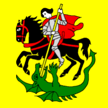
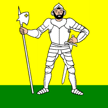

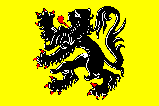
Flag of Corminboeuf, Switzerland (fotw); Flag of Spiringen, Switzerland (fotw);
Arms of Pregrada, Croatia (fotw);
Flag of Flanders, Belgium (fotw)
- ARMED AND LANGUED (or ARMED, LANGUED AND MEMBERED)
- See ‘armed 2)’,
‘langued’ and
‘membered’.
-
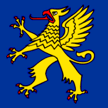
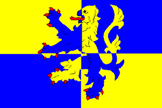

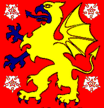
Flag of Balzers, Liechtenstein (fotw);
Flag of Valdice, Czech Republic (fotw);
Arms of Košice, Slovakia (fotw);
Flag of Östergötland, Sweden (fotw)
- ARMED SERVICES FLAG(S)
- A generic term for any flag that pertains to, or represents a branch of the armed services,
or a unit within that branch.
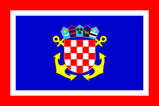
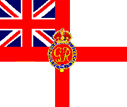
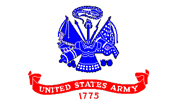
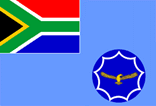
Naval Jack, Croatia (fotw);
Colour of the Royal Navy, UK (fotw);
Flag of the Army, US (fotw);
Air Force Ensign, South Africa (fotw)
Please note however, that the various types of flags
used by the armed services – for example an appointment flag, branch of service
flag, camp flag, colour, flag of command, guidon, naval jack, positional or rank flag,
etc. – are
separately defined herein and are, we suggest, to be preferred in description.
- ARMES PARLANTES
- See ‘canting’.
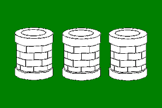

Flag and Arms of Tři Studnĕ (or Three Wells), Czech Republic (fotw &
ICH)
- ARM FLASH (or PATCH)
- See ‘badge 3)’ and
‘regimental colours 2)’ (also
‘military crest’).
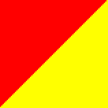
Arm Flash/Patch of The Royal Armoured Corps, UK
- ARMIGEROUS
- (adj) Possessing or showing a coat of arms - see ‘coat of arms 2)’ (also
'armorial bearings' and 'blazon').



Coat of Arms of the 10th Duke of Richmond, UK (Wikipedia),
Coat of Arms of the 11th Duke of Marlborough, UK (Wikipedia);
Coat of Arms of the 10th Duke of Buccleuch, UK (Wikipedia)
- ARMISTICE DAY FLAG
- See ‘service flag 3)’.
![[example]](../images/v/vxt-d1106.gif)
Armistice Day Flag/American War Mothers, US (Dave Martucci)
- ARMORIAL BANNER
- 1) See ‘banner of arms’.
- 2) A term that may also be used when the banner concerned contains all or some of the elements
from a coat of arms, but where that flag and those arms differ in their layout, and/or in the
detail/quantity of any such charges – but see ‘armorial flag 2)’
(also ‘coat of arms 2)’.
![[Aleksandrów Kujawski]](../images/v/vxt-d015.gif)
![[Aleksandrów Kujawski]](../images/v/vxt-d015a.gif)
![[Černotín]](../images/v/vxt-d1985b.gif)
![[Černotín]](../images/v/vxt-d1985a.gif)
![[Černotín]](../images/v/vxt-d1986a.gif)
![[Bądkowo]](../images/v/vxt-d1986b.gif)
Armorial Banner and Arms of Aleksandrów Kujawski Rural District according to def 1), Poland (fotw);
The Flag and Arms of Černotín, Czech Republic and of
Bądkowo, Poland according to def 2) (fotw)
Please note that the extension of this term, as given in definition 2), has been introduced by the
Editors as no established alternative could be found.
- ARMORIAL BEARINGS
- All the armorial insignia to which an individual or family, a corporate
institution such as a nation, province or municipality, or a commercial
enterprise are entitled – an achievement of arms or complete (armorial)
achievement or establishment of arms –
but see note below for further details (also ‘greater arms’ and
‘state arms 2)’ under ‘arms’,
‘blazon’,
‘coat of arms 1’),
‘quarters’,
‘quartering’ and
‘quarterly’).
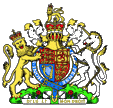

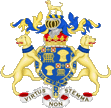
The Armorial Bearings of HM Queen Elizabeth II
(for use in England, Wales and Northern Ireland), UK (Graham Bartram); Armorial Bearings of The Bahamas (fotw);
Armorial Bearings of the Duke of Westminster, UK (Wikipedia)
Please note, however, that (as is shown above) a full set of
armorial bearings can include (for
example) shield, supporters, helmet, torse, crest, collar, mantling, compartment,
motto etc., and whilst many of the terms used are illustrated in
Appendix IV and/or briefly defined herein,
it is suggested that a suitable glossary or heraldic dictionary
be consulted for full details.
- ARMORIAL ENSIGN
- 1) The term that is used to to describe a historical naval ensign which displays a full set of
armorial bearings, usually (but not invariably) against a plain field (see also
‘armorial bearings’,
‘armorial flag 1)’,
‘armorial flag 2’ and
‘naval ensign’ under
‘ensign’
2) A newly extended term that is intended to cover a British or British-style ensign
(or a canton flag) whose fly is defaced with a set of armorial bearings or the escutcheon therefrom (see also ‘archivexillum’,
‘armorial bearings’,
‘blue ensign’,
‘canton flag’,
‘escutcheon’,
‘government ensign’ under
‘ensign’ and
‘red ensign’).
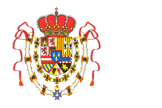
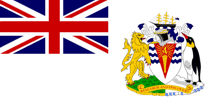
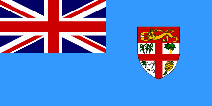
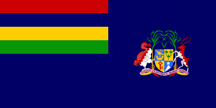
From left: State and War Ensign, Spain 1701-1759 (fotw);
Flag of British Antarctic Territories (fotw);
National Flag of Fiji (fotw); State Ensign of
Mauritius (fotw)
- ARMORIAL FLAG
- 1) Generically, a term that covers any flag showing all or part of an entity’s armorial
bearings against a field of any description (see also
‘armorial bearings’, ‘banner of arms’ and
‘coat of arms 2)’).
- 2) Specifically, a term that covers any flag whose main charge is a set of armorial
bearings or a part thereof, and which is set against either livery colours or a plain
field – but see ‘armorial banner 2)’, ‘ensign-banner’ (also
‘banner of arms’,
‘charge 2)’,
‘livery colours’ and
‘plain 2)’
and ‘seal flag’).
![[New Jersey, US]](../images/v/vxt-d600.gif)
![[New Jersey, US]](../images/v/vxt-d600a.gif)
![[Białogard Rural District]](../images/v/vxt-d1987.gif)
![[Białogard Rural District]](../images/v/vxt-d1987a.gif)
![[Bibinje, Croatia]](../images/v/vxt-d600c.gif)
![[Bibinje, Croatia]](../images/v/vxt-d600b.gif)
![[Chodouny]](../images/v/vxt-d600e.gif)
![[Chodouny]](../images/v/vxt-d600d.gif)
From left: Flag and Arms of New Jersey, USA (fotw);
Flag and Arms of Białogard Rural District, Poland (fotw); Flag
and Arms of Bibinje, Croatia fotw);
Flag and Arms of Chodouny, Czech Republic (fotw)
Please note that this term has been introduced by the
Editors since no established alternative could be found.
- ARMORIAL SAIL
- A term for the largely (but not entirely) obsolete practice of having all or a part of a coat
of arms displayed on a vessel’s sail (see also
‘armorial bearings’,
‘coat of arms’
and ‘flag sail’).
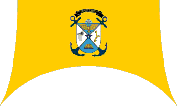
NCO Naval School, Colombia (Eugene Ipavec)
- ARMOURED
- 1) In vexillology a term that may be used when a human figure, or any part thereof, is clad in armour
- but see ‘harnysed’ and
‘vambraced’.
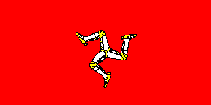
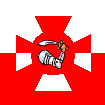
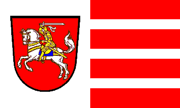
From left: Flag of the Isle of Man, UK (fotw);
Navy Jack of Poland (fotw); Flag of Dithmarschen, Germany (fotw)
Please note that the heraldic term for being clad in armour is “harnysed”
(harnessed), or in the case of the arm only “vambraced”.
- ARMS
- See ‘armorial bearings’,
‘coat of arms’ and
‘shield’ , together with
‘greater arms’,
‘lesser arms’,
‘middle arms’ and
‘state arms’ below
(also ‘civic arms’ and
‘flag arms’).
- Greater Arms
- In largely northern European usage, an official description for the full set of armorial
bearings of a nation or province – but see
‘middle arms’,
‘lesser arms’ and
‘state arms 2)’
(also ‘armorial bearings’,
‘coat of arms 1)’
and ‘coat of arms 2)’)

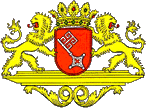
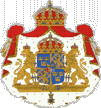
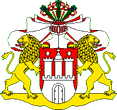
Greater Arms of the Czech Republic, Bremen, Germany and of
Sweden and of Hamburg, Germany (fotw)
- Lesser Arms
- In largely northern European usage, the most simplified form in which the set of armorial
bearings of a nation or province may be officially shown – but see
‘greater arms,
‘middle arms’ and
‘state arms 1)’
(also ‘armorial bearings’,
‘coat of arms 1)’
and ‘coat of arms 2)’)




Lesser Arms of Bavaria, Germany, Sweden, Hamburg, Germany,
and Czech Republic (fotw)
- Middle Arms
- In largely northern European usage, a simplified form in which the set of armorial bearings
of a nation or province may be officially shown – but see
‘greater arms’,
‘lesser arms’ and
‘state arms 1)’
(also ‘armorial bearings’,
‘coat of arms 1)’
and ‘coat of arms 2)’)

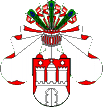
Middle Arms of Bremen
and of Hamburg, Germany (fotw)
- State Arms (or Coat of Arms)
- 1) Generically any coat of arms or emblem that is considered representative of a nation or of
a nation state – the national arms (see also
‘lesser arms’ and
‘middle arms’,
‘coat of arms 1)’
and ‘coat of arms 2)’,
‘emblem, state or national’
and ‘sash 1)’).
- 2) Specifically the establishment of arms that officially represents a nation state, as opposed
to any part (or parts) therefrom, or those of the relevant head of state or of any variation which
may appear on a flag (see also
‘establishment of arms’,
‘flag arms’,
‘greater arms’,
‘imperial arms’,
‘presidential arms’ and
‘royal arms’).
- 3) The term may also be used to describe the arms of a sub-national division within a
nation, particularly if that division is called a “state” – the provincial, cantonal or
territorial arms and similar (see also ‘state flag 2)’).
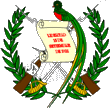

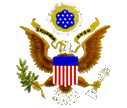

State/National Arms of Guatemala (fotw); State/National Arms of
Ecuador (fotw); State/National Arms of the United States (fotw); Arms of the State of
New Jersey, US (fotw)
- ARMY ENSIGN
- In British Army usage and some others, the term for an ensign (different from the branch of service
flag) that is flown at sea by army vessels (see also
‘branch of service flag’ and
‘government ensign’ under
‘ensign’).
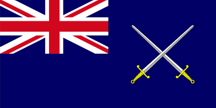
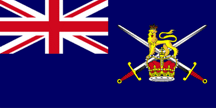
Army Ensign, UK (fotw);
Ensign (in abeyance) of an Army Vessel Commanded by a Commissioned Officer (fotw)
- ARMY FLAG
- See ‘branch of service flag’
(also ‘armed services flag’).
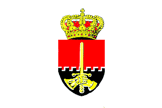
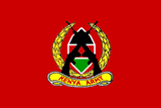
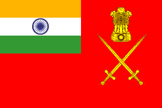
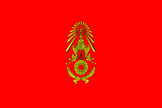
Army Flag, Belgium (fotw);
Army Flag, Kenya (fotw);
Army Flag, India (fotw);
Army Flag Thailand (fotw)
- ARRONDISSEMENT FLAGS/PENNANTS
- See ‘registration flags’.
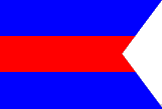
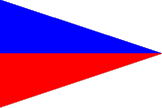
Arrondissement Flag and Pennant, Department of Lorient, France (fotw)
- ARROW CROSS
- A reputedly early Medieval symbol in the form of four connected arrowheads, that
became (1940 - 1945) the emblem of the Hungarian Nazi Party (the Nyilaskeresztes Párt) and occasionally used elsewhere –
a cross barbed – see ‘swastika’
(also ‘rogacina’ and
‘sun cross’).
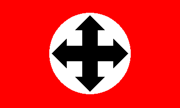
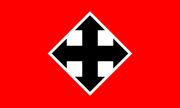
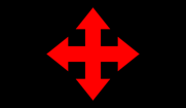
Flags of the Nyilaskeresztes Párt, Hungary 1940-1945; Former Flag of the Falange Venezolana, Venezuela (Tomislav Todorovic)













![[Aleksandrów Kujawski]](../images/v/vxt-d015.gif)
![[Aleksandrów Kujawski]](../images/v/vxt-d015a.gif)
![[Černotín]](../images/v/vxt-d1985b.gif)
![[Černotín]](../images/v/vxt-d1985a.gif)
![[Černotín]](../images/v/vxt-d1986a.gif)
![[Bądkowo]](../images/v/vxt-d1986b.gif)







![[New Jersey, US]](../images/v/vxt-d600.gif)
![[New Jersey, US]](../images/v/vxt-d600a.gif)
![[Białogard Rural District]](../images/v/vxt-d1987.gif)
![[Białogard Rural District]](../images/v/vxt-d1987a.gif)
![[Bibinje, Croatia]](../images/v/vxt-d600c.gif)
![[Bibinje, Croatia]](../images/v/vxt-d600b.gif)
![[Chodouny]](../images/v/vxt-d600e.gif)
![[Chodouny]](../images/v/vxt-d600d.gif)


































![[example]](../images/v/vxt-d1106.gif)
